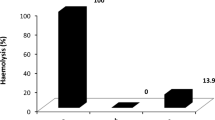Summary
Human erythrocyte cytoplasm was incubated in head space vials with either methyl bromide or methyl iodide. The decline in concentration of the two methyl halides was monitored by gas chromatography. Simultaneously, the production of S-methylglutathione was determined by thin layer chromatography. In parallel experiments, boiled erythrocyte cytoplasm was used in order to determine non-enzymatic conjugation. Furthermore, inhibition experiments with sulfobromophthalein were performed. The results were compared with previous findings on the metabolism of methyl chloride. In contrast to methyl chloride, both methyl bromide and methyl iodide showed a significant non-enzymatic conjugation with glutathione. In addition, an enzymatic conjugation could be observed in the erythrocyte cytoplasm of the majority of the population, whereas a minority lacks this enzymatic activity. This is consistent with findings on methyl chloride. Inhibition experiments show that a minor form of the erythrocyte glutathione transferase may be responsible for the enzymatic conjugation. Of the three monchalogenated methanes, methyl bromide is the substrate with the highest affinity for the conjugating enzyme(s). In the case of methyl iodide, non-enzymatic reaction overweighs the enzymatic process. There are possible implications of the results for occupational health and the toxicity of the substances.
Similar content being viewed by others
References
Appel GB, Galen R, O'Brien J, Schoenfeldt R (1975) Methyl iodide intoxication. A case report. Ann Int Med 1982:534–536
Awasthi YC, Singh SV (1984) Purification and characterization of a new form of glutathione S-transferase from human erythrocytes. Biochem Biophys Res Commun 125:1053–1060
Boyum A (1964) Separation of white blood cells. Nature 204:793–794
Chellman GJ, Russell DW, Norton RM, Bus JS (1986) Inhibition of the acute toxicity of methyl chloride in male B6C3F1 mice by glutathione depletion. Toxicol Appl Pharmacol 85:93–104
Doorn R van, Borm PJA, Leijdekkers Ch-M, Henderson PTh, Reuvers J, Bergen TJ van (1980) Detection and identification of S-methylcysteine in urine of workers exposed to methyl chloride. Int Arch Occup Environ Health 46:99–109
IARC, Int Agency Res Cancer (1986a) Methyl chloride. In: Monographs on the evaluation of the carcinogenic risk of chemicals to humans, vol 41, pp 161–186
IARC, Int Agency Res Cancer (1986b) Methyl bromide. In: Monographs on the evaluation of the carcinogenic risk of chemicals to humans, vol 41, pp 187–212
IARC, Int Agency Res Cancer (1986c) Methyl iodide. In: Monographs on the evaluation of the carcinogenic risk of chemicals to humans, vol 41, pp 213–252
Jiang XZ, White R, Morgan KT (1985) Structural study of lesions induced in the cerebellum of mice by inhalation exposure to methyl chloride. Neurol Toxicol 6:93–104
Johnson MK (1966) Studies on glutathione S-alkyltransferase of the rat. Biochem J 98:44–55
Kornbrust DJ, Bus JS (1983) The role of glutathione and cytochrome P-450 in the metabolism of methyl chloride. Toxicol Appl Pharmacol 67:246–256
Lewalter J, Korallus U (1985) Blood protein conjugates and acetylation of aromatic amines. Int Arch Occup Environ Health 56:179–196
Marcus CJ, Habig WH, Jakoby WB (1978) Glutathione transferase from human erythrocytes. Arch Biochem Biophys 188:287–293
Medinsky MA, Bond JA, Dutcher JS, Birnbaum LS (1984) Disposition of (14C)methyl bromide in Fischer-344 rats after oral or intraperitoneal administration. Toxicology 32:187–196
NIOSH, Natl Inst Occup Safety Health (1984) Monohalomethanes. Methyl chloride CH3Cl, methyl bromide CH3Br, methyl iodide CH3I. Current Intelligence Bull 43; DHHS Publ No 84-117, Cincinnati, OH
Nolan RJ, Rick DL, Landry TD, McCarty LP, Agin GL, Saunders JH (1985) Pharmacokinetics of inhaled methyl chloride (CH3Cl) in male volunteers. Fund Appl Toxicol 5:361–369
Peter H, Deutschmann S, Reichel C, Hallier E (1989) Metabolism of methyl chloride in human erythrocytes. Arch Toxicol 63:351–355
Redford-Ellis M, Gowenlock AH (1971a) Studies on the reaction of chloromethane with human blood. Acta Pharmacol Toxicol 30:36–48
Redford-Ellis M, Gowenlock AH (1971b) Studies on the reaction of chloromethane with preparations of liver, brain and kidney. Acta Pharmacol Toxicol 30:49–58
Seidegard J, Vorachek WR, Pero RW, Pearson WR (1988) Hereditary differences in the expression of the human glutathione transferase active on trans-stilbene oxide are due to a gene deletion. Proc Natl Acad Sci USA 85:7293–7297
Strange RC, Johnson PH, Lawton A, Moult JA, Tector MJ, Tyminski RJ, Cotton W (1982) Studies on the variability of glutathione S-transferase from human erythrocytes. Clin Chim Acta 120:251–260
Verberk MM, Roojakkers-Beemster T, De Vlieger M, Vliet AGM van (1979) Bromine in blood, EEG and transaminases in methyl bromide workers. Br J Int Med 36:59–62
Warholm M, Guthenberg C, Mannervik B (1983) Molecular and catalytic properties of glutathione transferase μ from human liver: an enzyme efficiently conjugating epoxides. Biochemistry 22:3610–3627
Author information
Authors and Affiliations
Rights and permissions
About this article
Cite this article
Hallier, E., Deutschmann, S., Reichel, C. et al. A comparative investigation of the metabolism of methyl bromide and methyl iodide in human erythrocytes. Int. Arch Occup Environ Heath 62, 221–225 (1990). https://doi.org/10.1007/BF00379437
Received:
Accepted:
Issue Date:
DOI: https://doi.org/10.1007/BF00379437




